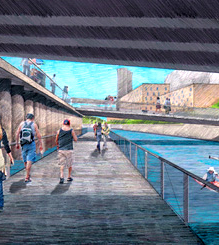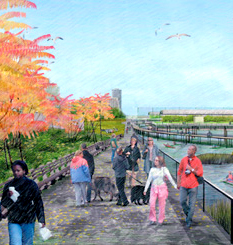Open Space in the Atlantic Yards Development
"A Garden of Eden grows in Brooklyn," announced the glossy brochure Brooklyn residents received in their mailboxes promoting the controversial Atlantic Yards development in Brooklyn. The brochure borrowed the words of former New York Times architecture critic Herbert Muschamp to promote developer Bruce Ratner's publicly subsidized mega-development slated to rise at the intersection of Atlantic and Flatbush avenues. In addition to building a Frank Gehry-designed basketball arena to bring the Nets to Brooklyn and 16 high-rises with up to 6,800 units of housing, the project promised open space and recreation for area with a severe shortage of parkland.
The Draft Environmental Impact Statement was released in July, giving the community its first chance to look closely at the details of a development that has skirted the usual public review process. Has the developer lived up to his promise for open space? Does the plan contain enough active and passive recreational space for the projected 15,000 or more new residents as well as the people who already live in the surrounding neighborhoods of Fort Greene, Clinton Hill, Boerum Hill, Prospect Heights, and Park Slope? Will the open space, set in between apartment towers, be truly public? And are there plans or mandates in place guaranteeing that the space's management, programming, and maintenance would make it accessible and inviting to the public?
What's There Now
No one disputes that the area surrounding the Atlantic Yards site has an acute lack of both active and passive open space.
The city's optimal goal for open space per thousand residents is 2.5 acres, of which 2 acres should be for active recreation. Anything less than 1.5 acres of open space per 1,000 residents is considered a deficiency of open space. At present, according the Draft Environmental Impact Statement's optimistic calculations of existing public space, there are just .36 acres of open space per 1,000 residents within a half-mile radius. Half of that acreage is for active recreation.
The amount of usable parkland is actually much lower than the statement indicates, however, because a third of the 23.79 acres it counts are mostly fenced-off greenery within the giant traffic circle known as Grand Army Plaza, one of the most treacherous intersections in Brooklyn. Another few acres are asphalt courts, or schoolyards and fields available for limited hours. The statement mentions other open spaces that it claims mitigate the shortage, such as community gardens, private plazas and public parks not officially within the area analyzed. These include Prospect Park, whose closest entrance is a good half-hour walk from the project site; heavily used Fort Greene Park; the exposed and unappealing plaza outside the Atlantic Terminal shopping mall; and even a few unshaded benches attached to planters at an entrance to the Atlantic Mall.
The Promised Parkland
Atlantic Yards includes seven acres of open space on top of a deck to be constructed over the Vanderbilt rail yards. The designer is Laurie Olin, the highly regarded landscape architect who designed Bryant Park and Battery Park City. All of the park space would be in the interior of two large blocks containing ten high-rise residential towers.
The open space plans include two playgrounds, a half basketball court, an active play area for bocce and volleyball, a large oval lawn, and trees, but no baseball or soccer fields. A curving walkway would continue the street grid through the middle of the space. There will be pools that hold water as part of the comprehensive storm water management plan.
In addition to the parkland, the project calls for an "Urban Room," a soaring lobby for the Nets arena that is to double as a community space. The developer originally promised a running track on the roof of the arena, but, said Forest City Ratner spokesman Joe DePlasco in an email, "We decided against sending the public to the roof for safety and design reasons, given how difficult it would be to provide access." Now, an acre of green rooftop is being reserved for private use by building tenants, which the environmental impact statement says will reduce the need for public open space.
On face value, the amount of open space is respectable. It constitutes almost a third of the project's 22-acre site. But because the towers would have so many residents -- with a projected 15,000 to 18,000 residents, it would become the densest census tract in the country -- the area within a half-mile radius would actually end up with a lower ratio of public space per resident that it has now, .28 acres per 1,000 residents. The percentage of active recreational space would drop to .15 acres. The already fully booked sports fields in Prospect Park and elsewhere in the area would not be able to absorb the overload.
Compare that to Battery Park City, which also has about a third of its 92 acres of residential and commercial development set aside as parks and fields. When completely built, it will have about 14,000 residents, so the ratio of parkland per 1,000 residents meets the city's goal of 2.5.
At Battery Park City, much of the parkland was put in before construction of the buildings. At Atlantic Yards, however, no parkland is slated to be constructed until the second building phase, which includes most of the residential towers, estimated to be completed in 2016. For families affected by a lack of places to play, ten years is most of a childhood. Also, the economic and real estate climate can change drastically over ten or more years. Changing financial circumstances could prevent the developer from finishing the green space as planned or create pressure to increase the footprint of the buildings.
In addition, according to the environmental statement, the multiple tall buildings will throw some of the existing public spaces into shadow and make them less likely to be used. Particularly affected will be the open space around the Atlantic Terminal Houses, which will get far less sunlight during the colder months. That would reduce the value of its open spaces for relaxation and recreation, and could affect the housing project's safety, because parks are much safer when people are using them.
The underlying assumption of the open space plan seems to be that it is acceptable for the developer to (eventually) keep the status quo, more or less. The environmental impact statement states, "It is recognized that [the city's minimum standards of parkland per capita] are goals that are not feasible in many parks of the city."
"Clearly the development requires more emphasis on open space and parks," said Christian DePalermo, executive director of the advocacy group New Yorkers for Parks. The group wants to see the amount of parkland increased and make it more accessible to the public. It is also lobbying for the creation of interim park space during the first phases of construction.
Public or Private Eden?
From the sketches available, the park space itself looks appealing. Yet it is surrounded and enclosed by tall buildings. Would it end up being used mostly by the residents of the towers? Would there be an invisible "keep out" sign, as in Stuyvesant Town or other apartment complexes with interior parks?
Forest City Ratner says that it has taken pains to create a publicly accessible space that invites the public in. "The entire space has been developed to create access for all, including sight lines that run through, open spaces, play spaces, walkways, and quiet places," said DePlasco. Entrances to the space have been designed so that the interior of the green space is visible from the sidewalks, and a tree- and bench-lined walkway continues Pacific Street through the larger of the two high-rise blocks. A southbound bicycle path would run through the project area.
Urban planning experts aren't convinced, however, that the design puts public access first. "A lot of the corridors are matched up with building entrances and areas that seem like outdoor lobbies," said Andy Wiley-Schwartz, vice-president at the Project for Public Spaces, a non-profit group that works to improve community life through public spaces. He is reviewing the open space part of the environmental impact statement as a consultant for the Council of Brooklyn Neighborhoods.
The Municipal Art Society, a nonprofit advocate for excellence in urban planning and design, conducted an eight-month analysis of Atlantic Yards. Regarding the open space component, it concluded that the parkland would serve primarily as a backyard for the residential skyscrapers. "Look at any successful park, and you'll see it's surrounded by streets," said Jasper Goldman, an advocacy associate at the society. "This is laying down buildings and then carving the park around it. We keep asking, 'Can you point to an example where a space configured like this functions as a public space?'" In concluding that the project in its present form does not work for Brooklyn, the society set forth five urban design principles by which the plan should be amended, including "Create a real public park."
Also important to consider is whether the rest of the development will have the scale and street life to attract pedestrians to the edges of the park. "Pedestrian movement is critical to the success of open space," said Wiley-Schwartz. Even now-before the addition of an arena, new stores and offices, and of more than 6,800 apartments-the site is a pedestrian's nightmare. Shoppers walking to its malls face a gauntlet of dangerous street crossings and a trek past blank walls on treeless sidewalks. Plans for the Atlantic Yards include planting street trees and providing retail space for bodegas and boutiques, the kinds of things that increase pedestrian traffic, but few details have been provided. "Who knows if that's going to happen?" said Wiley-Schwartz.
Another reason planning experts lack confidence in the park plans is developer Bruce Ratner's poor track record in this area. They argue that previous Brooklyn developments, including the Atlantic Mall and Metro Tech, have contributed almost nothing to public open space or a vibrant street life. "If your plan was to be public and provide open access, the project has the wrong combination of developer and architect," said Wiley-Schwartz. "You've got an architect who builds suit-of-armor buildings that repel people from their edges. The exterior of the Bilbao Musuem is famously unsafe. And you've got a developer who builds tower-moat projects."
It is also not clear whether the 10,000-square-foot "Urban Room" in the arena will function as intended. "It is being marketed as the Grand Central for Brooklyn, but it's configured like it's going to be a lobby to the arena," said Goldman. "Will it function as a public space given that?"
"We do hope people use the Urban Room to access activities at the arena," said Pelasco of Forest City Ratner. "But beyond that, we hope that it is a comfortable place to just sit, rest, and watch other people. There will be programming there as well, including music, art displays and other activities."
How Will It Be Managed?
Even more than its design, the way a park is managed is the most important factor in making a truly public space, according to planners. "That's true for any park anywhere," said Wiley-Schwartz. "If Bryant Park was as beautiful, but didn't have chairs, ice-skating, wi-fi, movies, and events, it wouldn't be the thriving open space that it is now."
To bring people into the Atlantic Yards park, said Wiley-Schwartz, its managers would need to create "events, destinations, and exciting things." But the interests of the residents would naturally tend to dominate the types of activities that would take place, he argued, effectively privatizing the space.
The proposed open space would not be public parkland; it would be owned by Forest City Ratner and be considered privately owned public space, like the so-called "bonus plazas" in midtown created in exchange for allowing the construction of taller buildings. Those spaces are governed by city law requiring they be properly maintained, identified, and open to the public, although the laws have not always been enforced.
"The only requirement we have is to create spaces that are inviting to all, and to ensure, to the extent possible, that they are safe," said DePelasco. "As with other spaces, these will close at night and there will be consideration for activities related to safety. But like Bryant Park and other public spaces that are part of residential areas, these will be open and alive while respectful of the people living nearby."
Neither the city nor the state appears to have set any requirements for maintenance or public access, or any enforcement mechanism.
Battery Park City offers a good example of how a large housing and commercial development can include parkland that is both a destination for visitors and an amenity for the neighborhood. There, most of the parkland is between the waterfront and the buildings. It is officially public parkland, although it is managed by a nonprofit conservancy and maintenance is funded largely by the residents of Battery Park City and its residential and commercial developers. Throughout the year, the conservancy offers activities ranging from classes for children to music festivals.
In the Atlantic Yards project, critics argue, the open space looks more like window dressing, something to make the huge towers more palatable to residents of tree-lined brownstone Brooklyn. They have concluded that the plan is woefully short on parkland, given the project's planned density and the privatizing design of the new open space. Counteracting good urban planning policy and design, critics argue, the development would actually worsen the existing deficiency of public open space, and overload the recreational infrastructure far beyond immediate area. It is also shortsighted from a purely economic viewpoint, they say, because well-maintained parks raise real estate values. Elected officials have lined up in support of the Atlantic Yards project, but they focus on the promise of affordable housing, jobs and a major-league sports team. What the officials forgot to notice, parks advocates argues, is that the emperor has hardly any parks.  Anne Schwartz, in charge of the parks topic page since its inception in 1999, is a journalist who specializes in environmental issues.Â
Anne Schwartz, in charge of the parks topic page since its inception in 1999, is a journalist who specializes in environmental issues.Â
Going Green: Three Parks Face The Future
Tradition vs. Renovation in Washington Square
By Shoshana Schwartz
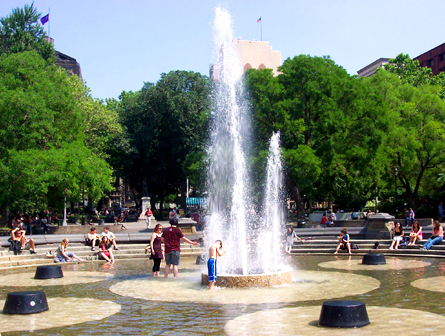
Many of the people who use Washington Square Park every day gravitate to a favorite section. For Wayne Monz, it is the chess area, where former world chess champion Bobby Fischer played. For high school student Rachel Sears, it is the lawn where she lounges and chats with her friends. Even the mounds -- the park's mysterious miniature black asphalt hills -- have their aficionados, such as Marianna Verkerk Joseph, who plays there with her children. But, if a planned renovation of the park becomes reality, all of these places could change.
And so, some community residents fear, could the whole nature of the park. They worry that the Greenwich Village park, known for its street performers, political debate and assortment of eccentrics, as well as its iconic arch, could become just another city park -- green and attractive but hardly distinctive.
The parks department, however, says the changes will improve the aesthetic quality of this park, while making it safer and more accessible to the disabled. According to the parks department, Washington Square has not had an overhaul in 25 years. As a result, the fountain system is leaky and dilapidated, and in need of drastic repair.
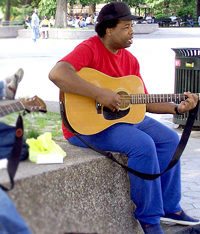 The $16 million renovation plan would move the fountain approximately 22 feet to align it with the Fifth Avenue Arch, construct a four-foot-high wrought iron fence around the park, eliminate the asphalt mounds, move the dog runs to the park's perimeter, and create a lawn in place of the plaza.
The $16 million renovation plan would move the fountain approximately 22 feet to align it with the Fifth Avenue Arch, construct a four-foot-high wrought iron fence around the park, eliminate the asphalt mounds, move the dog runs to the park's perimeter, and create a lawn in place of the plaza.
While New Yorkers generally welcome improvements to their local parks, the Washington Square Park renovations have attracted much opposition. Critics claim that the parks department is instituting an expensive redesign plan that most park users don't want. According to the Project for Public Spaces, an organization commissioned by the parks department to study the park's usage, "While people see the need for upgrades of certain current facilities and amenities (pavement, bathrooms, etc.), they like the park the way it is."
The renovations were scheduled to start as early as May. Before that could happen, four residents filed suit against the parks department over the size of the fountain plaza. The petitioners also charged that the proposed 45-foot spray of water from the fountain would limit people's ability to use the surrounding area.
In late July the state Supreme Court ruled against the city and the parks department. In her decision, Judge Emily Jane Goodman said the city had not provided Community Board 2 and the Landmarks Commission with adequate information concerning the plans for the fountain and surrounding plaza. The ruling put the renovation on hold.
The redesign plan does have supporters. Emily Kies Folpe, author of "It Happened on Washington Square," thinks the opponents have received more attention than they deserve. "There are many more people than newspapers would have you think who are perfectly happy to have this renovation go forward," she said. "It's really a very small number of people who have been putting forth a lot of anger and opposition."
One dispute concerns the way the park is used. The study by the Project for Public Spaces notes that "people stay in the park, they don't simply pass through." Opponents of the redesign worry that the proposed reconstruction would transform the park from a "hang out" place to a park that "you just walk through." The park is "a meeting and gathering place of opinions and ideas," said David Lawrence, manager of the park's small dog run. Many residents fear that that will be lost.
Another disagreement concerns the park’s history. Washington Square Park, built in the 1820s, has already been through a series of renovations. And the parks department notes that "use of public space in Washington Square Park has...been redefined" throughout the 19th and 20th centuries.
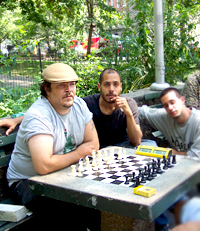 But many in the neighborhood think that the park's current design will best preserve its historic character. "The neighborhood likes the park the way it is," Marianna Joseph said. "We just want it to be cleaned up."
But many in the neighborhood think that the park's current design will best preserve its historic character. "The neighborhood likes the park the way it is," Marianna Joseph said. "We just want it to be cleaned up."
Some chess players want to keep the chess area as it is because Fisher played there and the movie "Searching for Bobby Fisher" was filmed there. But the parks department has said it might reduce the number of chess tables as part of its efforts to fight drug dealing in the park.
Another controversy surrounds the asphalt mounds. The plan would eliminate them, but some residents would like to see them saved. The mounds used to a playground, and people have proposed that a playground, intended for somewhat older children, be built there now. The park currently has two playgrounds, but both are crowded and intended for toddlers and younger children. The parks department says it will create new playgrounds, but that their locations will depend on the outcome of the litigation.
Some residents are also concerned about the proposed fence around the park, claiming that it would detract from the park's feeling of openness. But Gil Horowitz, president of the Lower 5th Avenue Block Association and chairman of the Community Relations Committee of the Square Arch Realty Corporation, points out that the park originally had a fence around it. The renovation, he said, "partially restores the feel of the original park, not as tall but partially."
Beyond the pros and cons of specific aspects of the plan, some in the community object to the way the parks department has made decisions.
"The parks department from the beginning has been dishonest about the design, has gone behind everyone's backs," said Leonie Haimson, a leader of community opposition to the park's redesign. "There is lots of resentment in the community about how the parks department went about this."
But Horowitz says that dissenters have had plenty of opportunity to voice their concerns: "The parks department has had over 100 meetings with community groups," he said, adding that the redesign "is one of the most discussed and debated topics in the community."
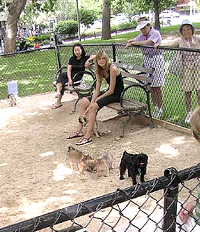 The park redesign is being funded by a private-public partnership, meaning that the city only has to pay $6.8 million of the $16 million in costs. Private businesses and other contributors will cover the rest.
The park redesign is being funded by a private-public partnership, meaning that the city only has to pay $6.8 million of the $16 million in costs. Private businesses and other contributors will cover the rest.
NYU made a $1 million donation. It says it supports the renovation as long as the park is available for commencement and the dog run is not moved in front of the library. The university, which dominates the surrounding area, is "agnostic" about the specific details of the plan, said Alicia Hurley, NYU's associate vice president for government and community affairs.
The parks department says the private-public partnership will provide enough money to pay for the renovations – and will even make possible a more extensive renovation than the city could have afforded on its own.
But, as with everything else about the renovation, there is dispute over the funding. Some critics worry that the private funding will place control of public property in private hands. And other New Yorkers question where the city will find the money to maintain the park. "They haven't found time and money to maintain what they have," said resident Karen Brooks. Eliza Nichols, the daughter of Robert Nichols who was the lead architect for the 1969 redesign, questions whether the parks department is taking on more than it can afford: "We're very afraid that we'll be stuck with a building site but no money for years."
A Cleaner, Safer Hell’s Kitchen Park
By Dan Rivoli
For years, parks department employee Frank Davis has been picking up litter in Hell’s Kitchen Park, on 10th Avenue between 47th and 48th Streets. The park, which opened to the public in 1979, had long been a haven for the homeless, peppered with broken beer and liquor bottles. For much of that time, it was an environment that reflected the shabbier aspect of neighborhood that surrounded it, Davis said. He recalls that he would “never see kids in the park before…. It was a dump.”
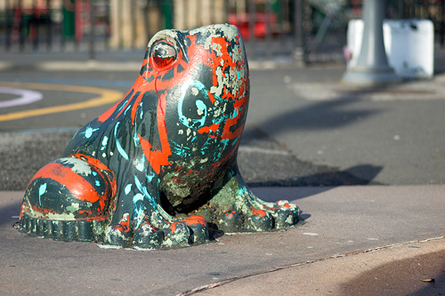
Now, though, a $1.24 million renovation of Hell’s Kitchen Park has made sunny days there picturesque: mothers chatting while their children rest in strollers or play and then cool off in the sprinklers. Others come to eat lunch or simply relax. The changes, spearheaded by community residents and the local block association, have also removed a source or crime and blight in the area.
Hell’s Kitchen Park is nestled between the large high-rise apartments and ground floor businesses that line 10th Avenue. Large trees grow around the perimeter of the park, providing shade. Thanks to the renovations, which were unveiled at a ribbon-cutting ceremony on May 16, an open space separates two playgrounds, equipped with clean water fountains and a red rubber mat for safety. For older kids and athletic adults, there are two graffiti-free handball and basketball courts.
 Before those with higher incomes started calling this piece of the West Side home, the area suffered from high crime. The park was a “drug den” and “a nice place for winos to drink,” said Elke Fears, president of the W 47 – W 48 Street Block Association
Before those with higher incomes started calling this piece of the West Side home, the area suffered from high crime. The park was a “drug den” and “a nice place for winos to drink,” said Elke Fears, president of the W 47 – W 48 Street Block Association
Since residents with higher incomes exerted their influence on the neighborhood, the park needed to follow suit. Residents worked hard to improve Hell’s Kitchen Park, said Fears, saying it “needed major renovations. The old, unsafe playground equipment needed to be replaced with safer, handicapped-accessible equipment.”
Crime was another issue. People came to the park to break the law because there were areas that could not be seen by the police from the outside. Now, thanks to the park’s new design, police can “see every corner,” Davis said. Before the renovation, the park did not have a fence, so there was nothing to stop people from sleeping on benches, or using drugs or alcohol at night. Now, the park features a fence, and it is against the law to be caught in Hell’s Kitchen Park when that fence is locked for the night.
The renovations finally were made in part because City Council Speaker Christine Quinn, who represents the district, used money from her discretionary fund.
Maintenance has been a joint effort by the parks department and members of the community, specifically the W 47 – W 48 Street Block Association..”
 The block association has “always been the shepherd of the park,” said John Doswell, co-chair of the waterfront and park committee for community board 4 “They kept it safe and kept their presence there,” he said. Community board 4 lends a hand as well.
The block association has “always been the shepherd of the park,” said John Doswell, co-chair of the waterfront and park committee for community board 4 “They kept it safe and kept their presence there,” he said. Community board 4 lends a hand as well.
Davis, the parks department employee, likens the care and maintenance of the park to that of a new car. When you get a new car, you want to keep it clean, he said.
Meanwhile other work remains to be done in this area of the far West Side. Doswell, co-chair of the waterfront and park committee for community board 4 says that De Witt Clinton Park, almost six times larger than the .58-acre Hell’s Kitchen Park, has yet to be renovated. “The larger park that needs attention is De Witt Clinton Park,” he said.
Gas Tank Park
By Alexander Perkins
For nearly a century, the Elmhurst gas tanks -- towering 200 feet above ground -- cast an imposing shadow over the local community and served as a landmark for commuters stuck in traffic on the Long Island Expressway.
“The tanks were an eyesore,” said City Councilmember Dennis Gallagher. And so, when the tanks outlived their usefulness, community residents fought to replace them with something more attractive.
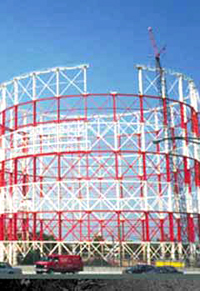 In 1996, the aging tanks, now obsolete, were torn down, and for the next five years, the KeySpan energy company parked its trucks on the lot.
In 1996, the aging tanks, now obsolete, were torn down, and for the next five years, the KeySpan energy company parked its trucks on the lot.
In 2001, KeySpan announced that it would sell the 6.5-acre property on 80th Road and 57th Avenue. While developers envisioned shopping malls and big box stores, some local residents saw a rare opportunity to build much-needed parkland.
A COMMUNITY PROPOSAL
The Maspeth, Middle Village, and Elmhurst areas of Queens –the most densely populated section of the borough - are known for their high voter turnout in local elections and for being one of the few places in the city to elect Republicans to local office.
These middle-class neighborhoods are also known for a lack of open space, with just two acres of parkland for over 167,000 residents. (See a community profile in pdf format)
Hearing the news that the Elmurst gas tank site was for sale, a local group, the Juniper Park Civic Association, distributed surveys to gauge the residents’ opinions about the vacant lot. Of the 500 responding , 73 percent said they wanted a park, 16 percent said they favored residential development, and 4 percent called for a shopping mall.
Surveys in hand, the Juniper Park Civic Association approached KeySpan and asked the company to donate the lot to the city for open space.
“They (KeySpan) told us it was out of the question,” said Robert Holden, president of the Juniper Park Civic Association.
Other local leaders joined the cause, concerned that new commercial development would bring more traffic and pollution to the area.
At a meeting of Queens Community Board 5 in 2002, board member Tony Nunziato confronted a KeySpan vice president. “We’ve paid for your service and you profited from us,” said Nunziato. “By selling it and not giving the land to the community, you’re disposing of our quality of life.”
In December 2002, KeySpan agreed to sell the land to the Mattone Group, a Queens based development and construction company, which hoped to put in a Home Depot, a self-storage facility, and a bank.
Flooded with letters and phone calls from concerned constituents, City Councilmembers Melinda Katz and Dennis Gallagher and State Assemblywoman Margaret Markey intervened. At a March 2003 meeting, KeySpan Chairman Robert Catell agreed to postpone the sale of the site for one year to allow the elected officials time to find funding to purchase the land for the city. The asking price: $12 million.
PROTESTING AGAINST DEVELOPMENT
Over the next year, with elected officials and community groups unable to come up with the $12 million, KeySpan proceeded with their plans to sell the land.
Devastated by the news of the pending retail development, residents of Middle Village, Maspeth, and Elmhurst formed a community task force to confront what some dubbed “the KeyScam problem.”
Frustrated residents planned protests, discussed a boycott of the energy giant, and even hung large banners criticizing the company on the Long Island Expressway.
“Let’s boycott and shut off our gas together…it’s time to say enough!” Tony Nunziato urged a group of residents.
The battle became a focal point of neighborhood politics.
“I couldn’t believe how upset people were…it was definitely a hot button issue around here,” said Middle Village resident Janitza Betances.
In a final effort to address the issue, former Republican City Councilmember Tom Ognibene wrote a letter to Michael Bloomberg calling for the mayor to get involved.
Mayor Bloomberg, (who would later face a challenge from Ognibene for the Republican mayoral nomination), contacted KeySpan Chairman Robert Catell.
A week later, Mayor Bloomberg announced that the gas company would transfer the land to the city for $1, and the city would transform the Elmurst gas tank site into a public park.
However, not everyone was happy with the new agreement – particularly those who believed the retail development would have created 350 new jobs and $15 million in tax revenue for the city.
“I just don’t understand the mayor’s priority and how he arrived at the decision he made,” developer Joseph Mattone told the Daily News.
When asked about the sudden change of heart, a KeySpan representative said that the heavily populated community was deserving of “more open space” and would not comment further.
FUTURE OF GAS TANK PARK
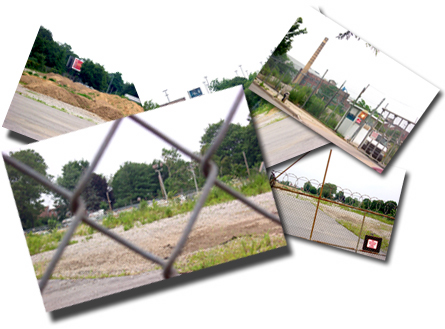
The site of the Elmhurst gas tanks
Although the deal between KeySpan and the city was brokered in 2003, the actual transfer of the land was delayed until November 2005 – four days before the reelection of Michael Bloomberg – because extensive environmental clean-up was necessary to meet the requirements of the Department of Environmental Protection for a public park.
With the park still in its tentative design stage, community leaders continue to stay involved by working closely with Partnership for Parks, a non-profit group, organizing community design meetings.
The community also debated what kind of park it should be: one with open green space or one filled with ball fields and recreational facilities. The Department of Parks and Recreation preferred the former.
Possible features of the aptly named “Gas Tank Park,” include trees to block out the neighboring Long Island Expressway, perimeter sidewalks, and a third of an acre playground.
The mayor and the City Council earmarked $20 million for park renovations, and the parks department anticipates construction to begin later this year.
“What’s certain is that it will be a welcome respite from city life, that will provide generations of Queens residents much needed recreation space,” said Parks and Recreation Commissioner Adriane Benepe.
Â
Funding the Parks Boom
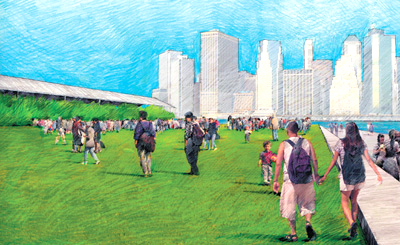
Artists conception of the proposed Brooklyn Bridge Park
The docks on the 1.3 miles of Brooklyn waterfront sit largely abandoned, their cavernous sheds empty, with only an occasional truck rattling by on rutted roads filled with weeds. But if all goes according to plan, by 2012 this remnant of the industrial New York of the 1950s will boast smooth pathways, playing fields, vibrant greenery and paddling kayakers along the shore.
Brooklyn Bridge Park is among the many new parks being constructed around the city. And like many of the others it will depend not just on taxpayer dollars, but on private funds.
Increasingly the city and state expect private groups to come up with the money to operate new parks. In Brooklyn Bridge Park, the plan is for this money to come from private luxury apartments within the park's boundaries. This proposal has sparked heated exchanges, angry rhetoric and a court fight. While an extreme case, the fight over Brooklyn Bridge Park is emblematic of the debate over how to pay for the city's green space.
ACRES OF NEW PARKS
The city is in the midst of a parks construction boom. Mayor Michael Bloomberg has said that, during his first term, the city added some 300 acres of parkland to the approximately 27,000 it already has. And more are on the way. Parks commissioner Adrian Benepe has predicted that 2006 will be the biggest year for parks construction in New York City since the 1930s. To help fund this, the parks department's capital budget has climbed from $550 million last year to $850 million the current fiscal year.
The projects are all over the city. A few examples:
-- The High Line: This abandoned elevated freight line in Chelsea will become one of the city's most unusual parks - a raised walkway with sidewalks, benches and landscaping.
-- Elmhurst Tanks: Using land donated by Keyspan, the city is converting another industrial site into a recreational center. (See related story.)
-- Fresh Kills: The plan to take the huge former garbage dump and make it a 2,315-acre park over the next 30 or 40 years is "the biggest and largest park project in the city's history," Benepe says.
-- The Bronx waterfront: The city's plan for Hunts Point calls for various waterfront parks and piers. While some of this is still just an idea, Barretto Point Park, also on a former industrial site, is set to open soon, complete with a beach, albeit off limits for swimming.
At the same time, the city is making improvements to other parks.(See related stories on Washington Square Park and Hell's Kitchen Park.)
This boom is the result of a number of things happening at once, said Benepe. Some projects long in the planning, such as Brooklyn Bridge Park, are finally coming to fruition. And, he said, the city has been actively seeking out new land, encouraging development of parks as part of new housing developments and considering even the unlikeliest of locations as a possible park site. The strong economy has also helped, Benepe said. (For more on planning parks, play Gotham Gazette's "Plan Your Future Park" game.)
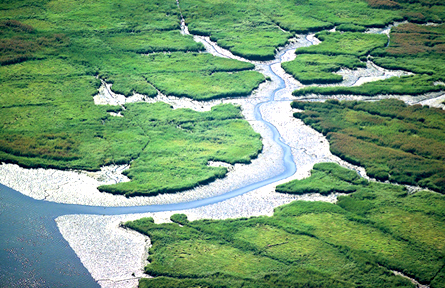
Fresh Kills
FUND THE PARKS
The department has seen its budget reach about $220 million, up from about $150 million 10 years ago. "Quietly, the operating budget has been growing," Benepe said, "and the expectation is that it will continue to do so." As the amount of parkland increases, he said, so will spending and staff.
But parks advocates say the spending is not sufficient to meet the city's demands. As evidence, Christian DiPalermo, executive director of New Yorkers for Parks, an advocacy group, cites a 60 percent decline in park staff over the last 20 years. And advocates say that New York spends less than other cities on park related expenses: $78 per resident, far below the $276 spent by San Francisco, which ranked first in a study of city parks by the Trust for Public Land.
Most of the advocates say the city has managed to stretch its money -- helped by private contributions, volunteers and use of temporary workers. But that can only go so far, they say.
And so, they charge, a shortage of funds has resulted in poor conditions at dozens of parks. In the Report Card on Parks by New Yorkers for Parks, 38 of the 220 parks reviewed got a D or an F. Although this is fewer than in the previous year, the group says, "The gap in performance in the highest and lowest scoring parks in New York City continues to grow." The differences among parks, it said, are "staggering."
But Benepe rejects such criticism. "By every indication, the parks of New York City have gotten better over the last 30 years," he said. "Citizens have become more engaged in their parks, and the parks have improved as a result."
THE SELF-SUSTAINING PARK

The proposed visitor center at Fresh Kills
In exchange for acquiring land for and building a new park, city and state officials now often want private groups to fund part, if not all of the yearly operating expenses.
This "privatization" effort goes back to the 1980s when the Central Park Conservancy was created. It gave rise to other private groups that raise funds for and work with the city to maintain a specific park.
But some parks have been left behind. In an article on the city's worst parks, Timothy Williams of the New York Times concluded, "What these parks have in common is that they rely almost exclusively on city money, while the city's best-maintained parks... are managed in part by private conservancies that raise money and hire workers."
SOURCES OF MONEY
Since parks do not charge admission, how can they raise funds? And with so many parks being renovated and constructed, how can the city insure that restrooms remain open, play equipment works and that all of New York's parks remains safe and inviting? In other words, how will New York keep today's new parks from falling into the disrepair that characterized so many parks in the 1970s?
A number of methods are being used or considered:
Money from Controversial Projects
Bronx parks are receiving $200 million in extra city funds. But to get it, borough officials had to let the city build a water filtration plant in Van Cortlandt Park. The money will fund some 70 projects in the Bronx, including renovation of St. James Park and a $1.1 million project, with landscaping and a new fence and lighting, at Grant Park. Residents also hope some of this money will go to develop the Bronx waterfront.
Renting Facilities
Bryant Park plays host to fall and spring fashion showings and a Christmas gift market, among other events. This has proved so successful that the park is entirely self-sustaining; it does not require any city operating funds.
Hudson River Park hopes to generate revenues from a banquet hall in its boundaries. But few other parks have Bryant Park's advantages -- a midtown Manhattan location next to the42nd Street library and on top of several major subway lines. And for those that do, this approach can work too well and then limit the general public's access to the park.
Private Contribution
The Bloomberg administration has increased efforts to seek out private donations to fund public services. In 2003, City Hall launched the Adopt-a-Park program, aimed at smaller parks and spaces outside of Manhattan. It encourages individuals or groups to sponsor a park, a facility or even a lawnmower by donating money or labor. Now, taking a cue from concert hall seats and church pews, the department is encouraging people to "buy" park benches and, in return, get a plaque commemorating a loved one. New York park lovers can also support a tree and at least one resident has purchased granite stones, inscribed with the name of a friend or relative, in Tompkins Square Park.
Concessions
Some 600 businesses -- skating rinks, golf courses, restaurants, etc. - operate in the parks and produce about $60 million a year to city coffers. But the money from these concessions is not designated for parks; it goes into general revenues. DiPalermo would like to see that change - as long, he says, as the shift is not used as an excuse to cut general city funds for parks by a similar amount.
Energy Projects
While Staten Island hardly holds the prospect of being the next Saudi Arabia, Fresh Kills does provide some energy resources. Pumps extract methane gas, which can be used to provide heat and electricity, from the now capped mounds of decomposing garbage. According to the master plan, "harvesting of methane could provide a significant source of revenue to offset operating costs."
And engineers are evaluating whether the landfill - which even on a stagnant summer afternoon enjoys a fairly stiff breeze--could be a good place for windmills. Even if technically feasible, the plan could face a number of political obstacles but it has the support of Staten island Borough President James Molinaro who has said he wants to "to erect a wind energy facility at the Fresh Kills landfill [that] will tackle tomorrow's energy challenges today, right here on Staten Island."
Despite the money from energy production and facilities such as restaurants, a banquet hall and golf course, the city anticipates that Fresh Kills, which will cost hundreds of millions to build and millions to operate, will require government funding.
Real Estate Development
New parks, and provisions for funding them, are key to some real estate developments, such as Battery Park City and the rezoning of the Williamsburg-Greenport Waterfront in Brooklyn.
Friends of Hudson River Park is considering taking this a step further. Some of the money to operate the park, now being built along Manhattan's West Side, will come from rents, concessions and eventually a banquet hall and marina. But many doubt whether this will cover all operating and maintenance expenses.
And so, the New York Observer has reported, supporters of the park are investigating whether area businesses and property owners could be required to pay a fee, similar to the kind of assessment levied in Business Improvement Districts, to finance the park. One rationale for this is that proximity to a park has been shown to increase property values. If that effort fails, advocates could press for some kind of voluntary contribution.
BROOKLYN BRIDGE PARK
|
The planned shed for Pier 2 in Brooklyn Bridge Park |
Brooklyn Bridge Park also hopes to rely on real estate development to support the facility - but with a difference. In Brooklyn Bridge Park, the apartments will be not on private land on the park's periphery but within the boundaries of the public park itself.
The plans for the park go back to the 1980s, as the Port Authority mulled what to do with the largely abandoned piers south of the Brooklyn Bridge. The Port Authority initially wanted to sell the piersto private developers so that most, if not all of the area would be built up and off limits to the general public. But many neighborhood residents, concerned about the paucity of green space in the area, pressed for the site to become a park. In 2002, the state and city agreed to build the park for about$150 million. In return, the park would have to fund its $15 million in annual operating and maintenance costs itself.
Various option were weighed but eventually the Brooklyn Bridge Park Development Corporation, a state agency, concluded the best idea would be to build private residences at either end of the park. While people debate the numbers, the three buildings, ranging from 95 to 315 feet high, would cover about 10 percent of the park's total area.
Marianna Koval of the Brooklyn Bridge Park Conservancy, a citizens group that supports the park, said the development corporation should have consulted with the community on the plan. Despite that, she said, her group has concluded the residential development offers the best solution to funding the park. "It's a great plan and a great vehicle," she said - with private space occupying less of the park than it had in previous proposals.
Noting that the land where the park would be is zoned for manufacturing, she said the site could have been converted to a residential development. Instead, in exchange for private buildings at either end of the long, skinny space, residents will get a park with more than 74 acres of open space and an array of recreational facilities.
But other Brooklyn residents object so strongly to the private buildings that they have filed suit to block the plan. They say they want a park but think expensive private housing in the park undermines the very nature of a public facility. "This became overnight a housing development with green space," said Judi Francis of the Brooklyn Bridge Park Defense Fund, a coalition which opposes the plan. "They have manufactured this very, very expensive park to justify building housing."
Opponents contend the private housing could create problems, such as traffic in the park. But more fundamentally they worry that turning over public space to such a private use creates a bad precedent.
Francis said her coalition is open to other means to financing the park - creating a more economical plan, charging fees for certain park facilities or somehow taxing people who live closest to the park extra to support it.
PUBLIC VERSUS PRIVATE
|
A promenade along a marshy inlet, slated for Brooklyn Bridge Park. |
For better or worse, these kinds of choices are not open to many New Yorkers. Park advocates and residents of geographically remote or poor areas worry that the rush to private funding will only widen the already sizable gap between parks in rich areas and those in poor ones.
"Real estate developers like the fact that they can charge more for park views and are willing to pay into a fund," Majora Carter, founder of Sustainable South Bronx has said, discussing plans for parks in her neighborhood. "We don't have that luxury here."
Benepe says parks will be built in poor areas - and they will be maintained. "At the end of the day, taking care of parks is a city responsibility," he said.
Francis agrees. Just as we have police and fire protection and mass transit, she said, "We can have great parks that are supported by the public."
Koval, though, dismisses such comments as "nai"ve." "I would like the government to pay for these parks," she said, "but it's not going to."
Â
